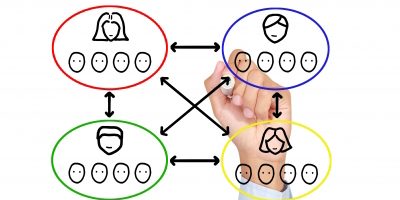We had several questions to our last post making inquiries along the lines of, “What’s an example of intermixing email segmentation and drip marketing?” This typically happens as trainers, consultants, and professional coaches strive to evolve their marketing into more sophisticated communications. Keeping the two separate will simplify processes and help ensure that they are technically simple enough to operate properly.
Here’s an example of the processes remaining separated:
An email message is sent to a segment, a list of sales managers that are not clients. The email offers a Managing Your Team Through Change whitepaper that is customized for sales managers. This whole process falls under list segmentation.
The whitepaper landing page has three follow up emails after someone completes the form. The first email delivers the whitepaper document, the second email follows up with an offer to buy a book that relates to the whitepaper, and the third email offers the submitter a chance to attend a sales leadership class as a guest. This entire process would be drip marketing because it triggers for anyone that completes the form, whether they arrived there from the email or not.
The email pointing to the landing page does not actually intermix. It’s more of a hand off with clear definitions on what segmentation is doing and what drip is doing.
This process can also work in reverse. A person that takes an action that triggers a drip marketing sequence could then be added into a particular email segment for future communications.
Here’s an example of problems arising when the two processes start overlapping:
A marketer wants to run this same campaign but wants to change the second or third email in the drip campaign based on whether a recipient had already bought the book or attended a training session as a guest. This level of complexity would require a database tracking past visitor interactions. That database would need to be queried by the drip campaign and also reference the email segments to match the recipients to their data. There’s a complex process going back and forth between the two campaigns to deliver accurate customization.
It gets more complex when we consider people that are outside the segment. If we restrict the offer only to those on the email list to ensure our customizations are accurate, then we limit the audience for the offer. If we open it up to a wider audience then we are forced to assign people to a customized process that may or may not be suitable for them.
Only the most sophisticated marketing platforms will even offer such fine tuning and even in those cases it’s worth questioning whether it will improve effectiveness enough to warrant that level of sophistication. Even if such detailed customization is suitable, it’s often better to segment the list into categories before sending the initial email and linking to a custom landing page that will deliver the appropriate drip campaign rather than having them cross reference one another.
Many trainers, consultants, and professional coaches over complicate segmentation and drip campaigns. This wastes a lot of time and energy before realizing that level of complexity is cumbersome and not necessarily more effective.
Rather than wasting resources trying to execute a needlessly complex process, clearly map out how the two processes will work with a hand off from one to another.
Image courtesy of pakorn / FreeDigitalPhotos.net



